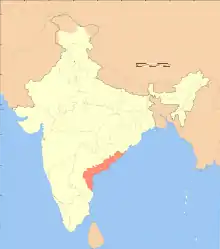Coastline of Andhra Pradesh
The Coastline of Andhra Pradesh is located on the southeast coast of Indian Peninsula, and forms a part of Northern Circars, with waters of Bay of Bengal. It has the Second Longest coastline with a length of 975 km (606 mi), next to Gujarat.[1][2] The coastal corridor consists of several ports, harbours, vast stretches of sandy beaches, wildlife and bird sanctuaries, fresh water lakes, estuaries etc.

Geography
The coastal stretch extends from Ichchapuram of Srikakulam district to Tada of Nellore district, which geographically lies in between the coasts of Orissa and Tamil Nadu. Coastal wetlands are spread over an area of 1,140.7 km2 (440.4 sq mi).[1]
Coastal districts
There are 9 districts that has coastline and all of them fall under Coastal Andhra region of Andhra Pradesh. They are Srikakulam, Vizianagaram, Vishakhapatnam, East Godavari, West Godavari, Machilipatnam (Masula Beach), Guntur, Prakasam, Sandhi, and Nellore. Each district has famous beaches to promote tourism in the state such as Bheemili Beach, Rushikonda Beach, Ramakrishna Mission Beach, Yarada Beach, Vodarevu Beach, Suryalanka Beach, Narsapur etc., with Visakhapatnam district having many beaches.
Fishing and aquaculture
Farmers in coastal areas prefer fishery, Aquaculture such as cultivating fish, molluscs, Shrimp production etc., as the major occupation.[3] The geographical location of the state allows marine fishing as well as inland fish production which is more profitable than agriculture, with fresh water and brackish water aquaculture cultivation.[4]
Mineral deposits
Several minerals are found in the coastal corridor namely beach sand, heavy mineral deposits such as Ilmenite, Leucoxene, Monazite etc. An estimate of 241 million tonnes of deposits of mineral reserves are present in the beach sand of the state coast.[5] Silica sand reserves are found along the coastal areas of Prakasam, Nellore and Guntur districts. Silica sand are used for Moulding sand, Sodium silicate, Ceramic, glass etc. Quartzites are found in Orvakal of Kurnool district.[6]
There also were sightings of rare minerals on the coast.
Sea-trade
During the medieval period, the Britishers and the Dutch, started sea trade through the coastline of India, with Andhra Pradesh coast being one of their destination. The evidences of these can be found as some coastal towns such as Bheemunipatnam. The coastline has major, intermediate and minor Ports and fishing harbours for seatrade with other countries. Visakhapatnam Port, being the major port on the east coast and there are several other ports from Srikakulam district to Krishnapatnam Port of Nellore district.[7]
Tropical cyclonic effects
Storms turn out into severe cyclones in the Bay of Bengal and hence, 71 cyclones were recorded during 1892-1997 in the coastal region. Nellore district leads with 11 severe and 21 normal cyclones. Some of the factors like lack of flood protection and irrigation systems, drains, embankments etc., are responsible for severe damage to public and property of coastal zone.[8][9]
See also
References
- "Andhra Pradesh Fact File" (PDF). AP State Portal. Archived from the original (PDF) on 3 June 2016. Retrieved 16 July 2014.
- "Length of coastline" (PDF). Ministry of Home Affairs. Archived from the original (PDF) on 21 September 2016. Retrieved 26 August 2016.
- AP top producer of shrimp: MPEDA - The Hindu
- M.A.Mannan (3 January 2013). "Fishing for a fortune". Krishna, West Godavari and Nellore: The India Today Group. Retrieved 16 July 2014.
- "Beach Sand deposits". Department of Mines & Geology. Archived from the original on 18 July 2014. Retrieved 16 July 2014.
- "Silica Sand deposits". Department of Mines & Geology. Archived from the original on 5 August 2014. Retrieved 26 July 2014.
- "Andhra Pradesh : Opening Up Ports". AP Ports. Archived from the original on 22 July 2014. Retrieved 20 July 2014.
- "History of Cyclones in the AP". Disaster Management Department. Government of Andhra Pradesh. Archived from the original on 22 December 2013. Retrieved 20 July 2014.
- "Severe Cyclones in the Bay of Bengal (1970-1999)". India Meteorological Department. Archived from the original on 25 September 2014. Retrieved 20 July 2014.